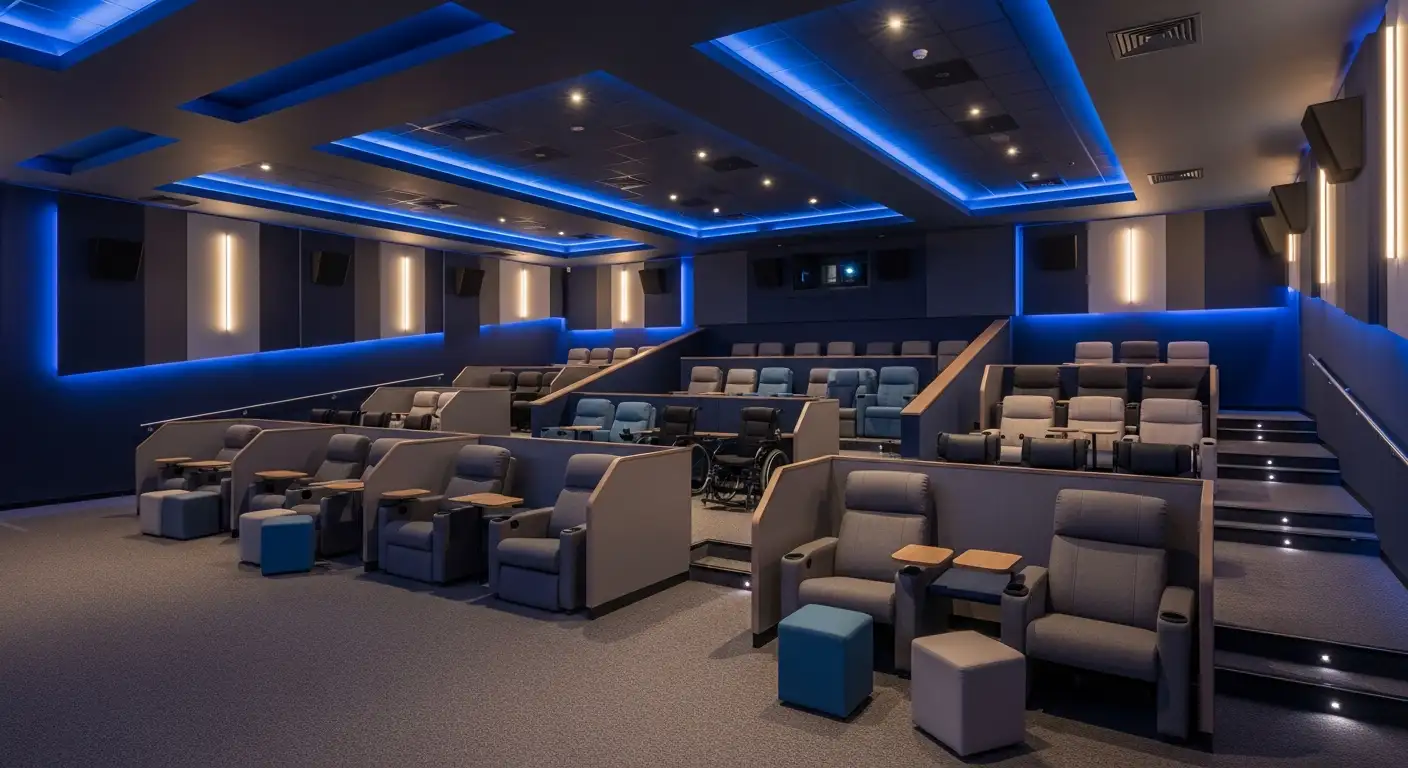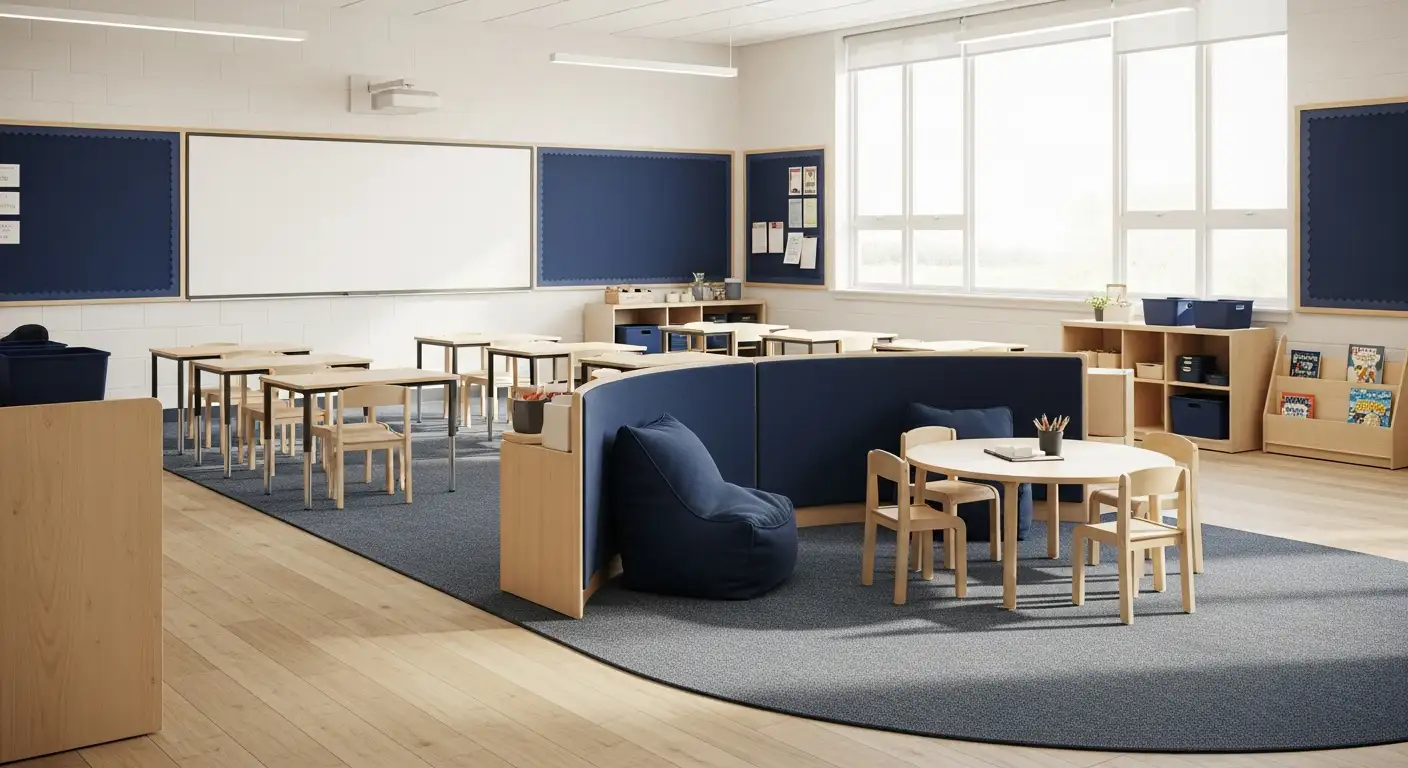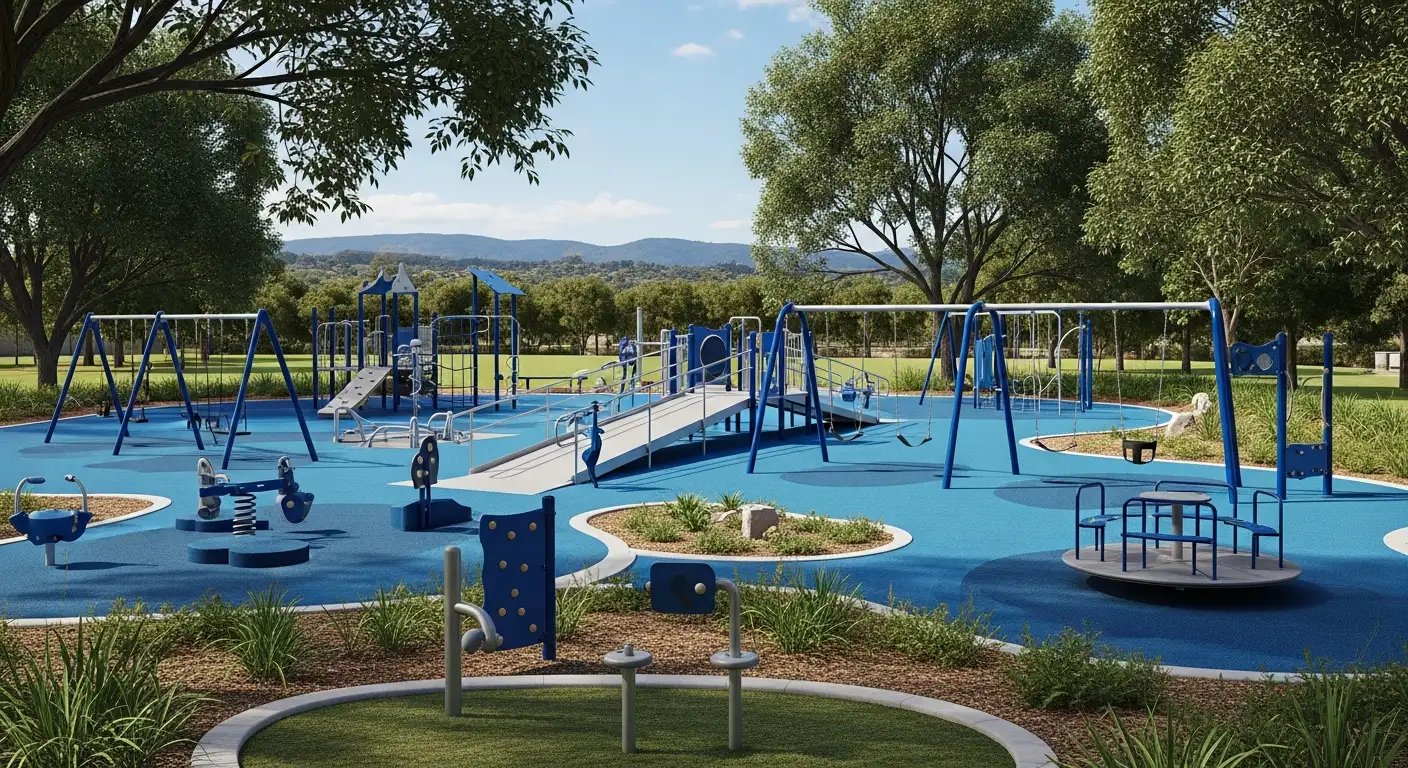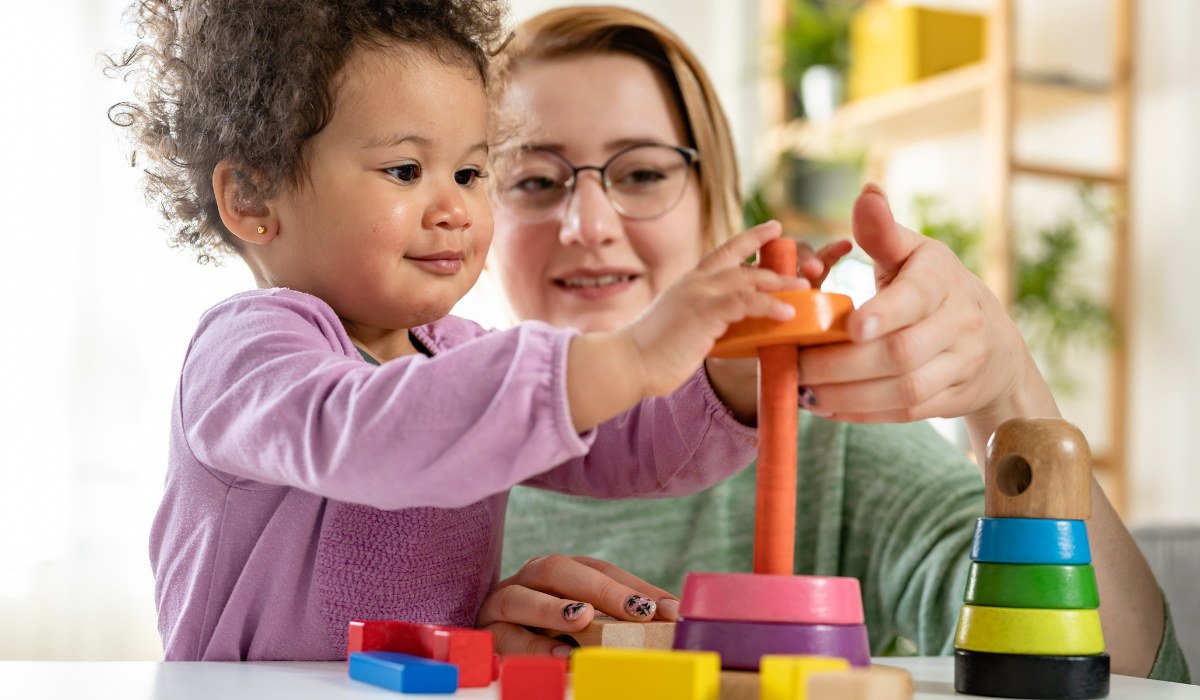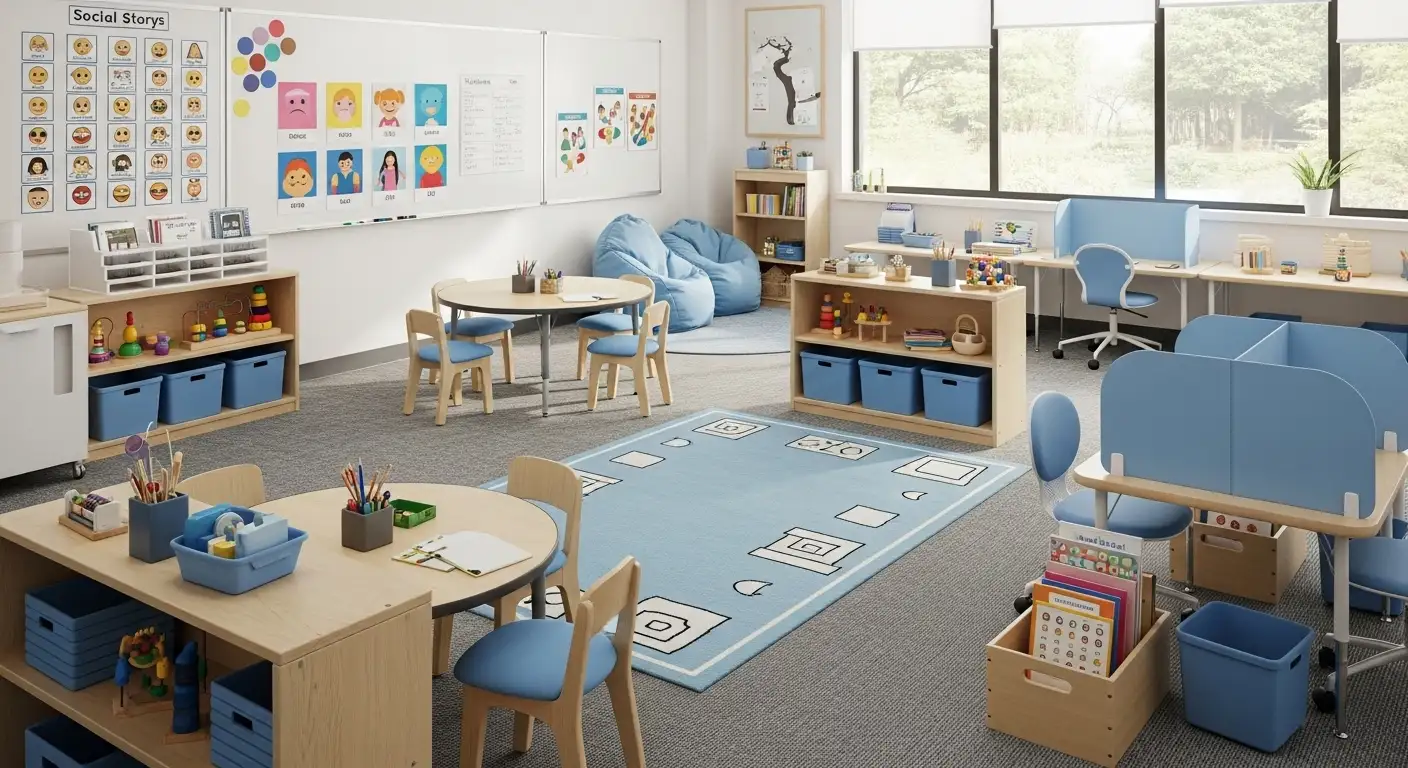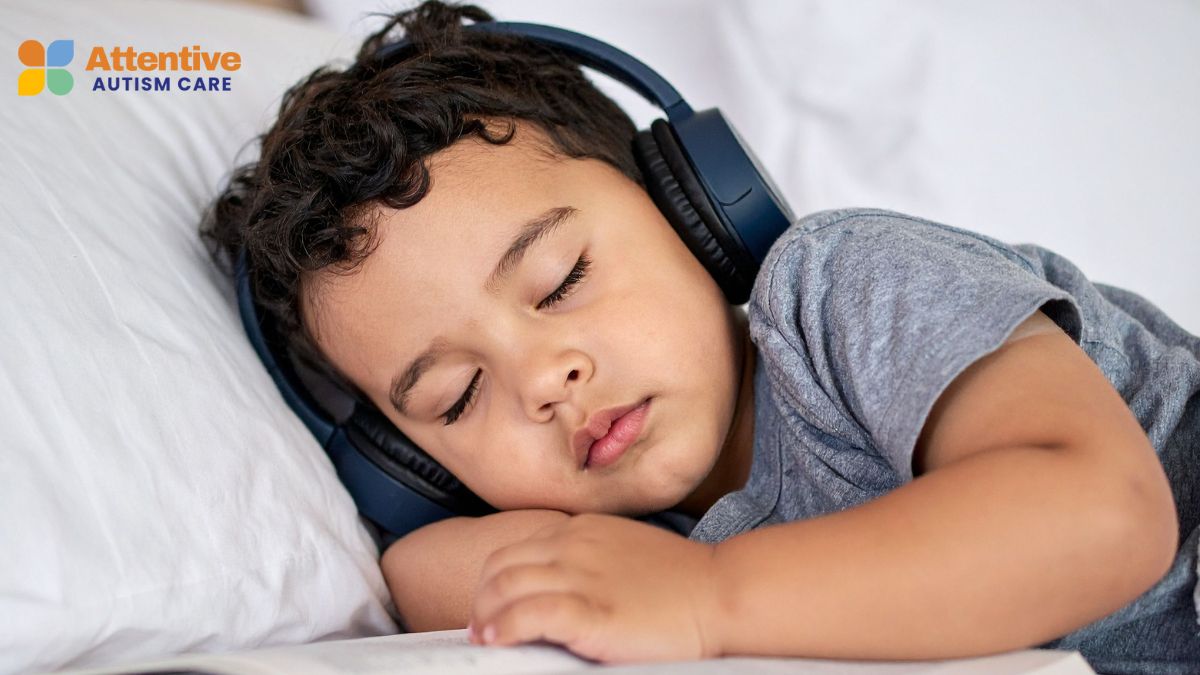The Impact of Autism on Motor Coordination
Understanding Motor Challenges in Autism for Better Support

Exploring the Connection Between Autism and Motor Functions
Motor coordination issues are a common yet often under-recognized aspect of autism spectrum disorder (ASD). From infancy through adulthood, individuals with autism frequently experience a range of motor difficulties that impact their daily lives, social participation, and overall development. This article delves into how autism influences motor skills, the scientific evidence backing these observations, assessment methods, and effective strategies for management, aiming to provide a comprehensive understanding of this critical aspect of autism.
Early Motor Differences in Infants and Their Significance
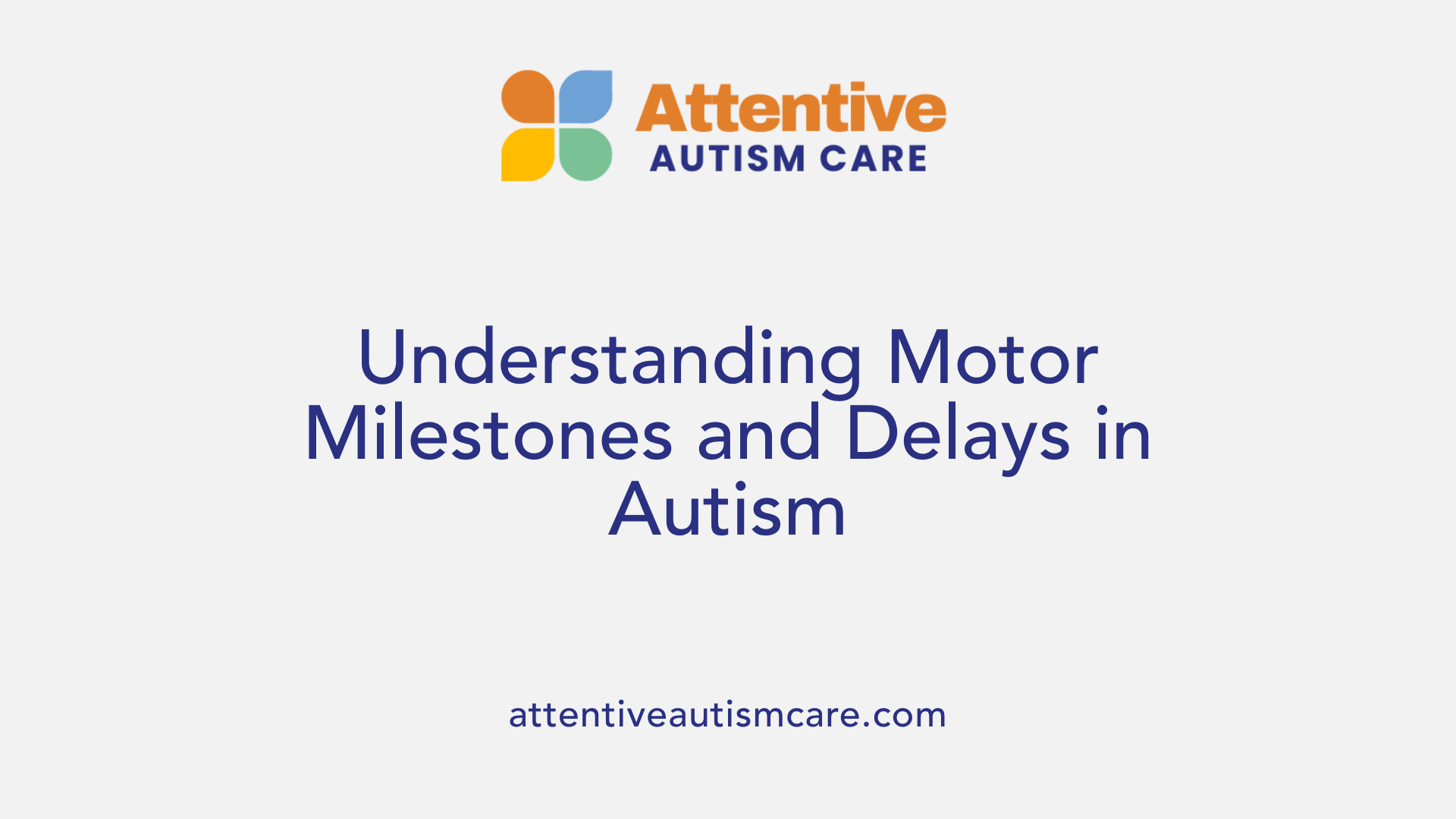
How does autism impact motor coordination and motor skill development?
Autism can significantly influence how children develop their motor skills, affecting both gross (large muscle groups) and fine (small movements) abilities. Many children with ASD face difficulties with balance, muscle tone, and coordination, which may manifest as challenges in walking, grasping objects, or handwriting. These motor issues are often evident early, leading to delays in key developmental milestones like crawling, sitting, and walking.
Research shows that motor deficits are present in up to 95% of autistic individuals, highlighting their prevalence. Such challenges can interfere with everyday tasks, participation in sports or social activities, and overall physical health. Early diagnosis of motor delays, along with interventions such as physiotherapy and occupational therapy, can help improve motor development and reduce the long-term impact on a child's life.
Children with autism often exhibit issues with motor planning and muscle strength, along with atypical gait patterns and postural instability. These motor differences are linked not only to physical difficulties but also to social communication, as motor skills play a vital role in social interactions and learning.
Assessments with tools like caregiver questionnaires and observational tests aid in identifying these problems early, providing crucial opportunities for intervention.
What are the core early signs of autism related to motor development?
Motor delays serve as important early markers of autism. Observations such as delayed sitting or crawling, reduced arm movement in infancy, and limited use of gestures during social interactions can signal developmental concerns.
Specific early signs include weak head control around four months, difficulty standing by 14 months, and problems grasping objects or sitting independently. These motor delays often appear alongside or ahead of behavioral signs and are critical for early diagnosis.
Research consistently emphasizes that early motor issues can predict later developmental outcomes. Recognizing these signs allows parents and clinicians to initiate interventions sooner, potentially improving communication, social skills, and overall growth.
Understanding Motor Development in Autism
Motor development depends on complex brain systems that coordinate sensory information, environmental inputs, and muscle control. In autism, differences in brain connectivity—such as reduced synchronization between visual and motor regions—may impair movement and balance.
Additional factors like sensory integration difficulties, low muscle tone, and hypermobility can also contribute to motor problems.
Gross motor activities such as trampolining, swimming, or playing on equipment help enhance balance and coordination. Fine motor activities like manipulating small objects or using scissors support dexterity development.
Incorporating everyday tasks, including dressing or using utensils, along with consistent practice, can foster motor skill improvement. Such activities not only promote physical development but also support social and emotional growth.
Importance of Early Motor Assessment and Intervention
Early identification of motor development delays can provide vital intervention opportunities. Standardized tests and emerging technologies like motion capture and sensors offer promising means to assess motor functions more precisely.
Interventions generally include physical and occupational therapies designed to enhance strength, coordination, and balance. Novel approaches—such as adapted sports, yoga, or movement therapies involving music—are gaining interest, although further research is needed to confirm their efficacy.
Overall, vigorous early intervention targeting motor skills can lead to better participation in daily activities, improved social interactions, and enhanced quality of life for children with autism.
| Motor Skills Affected | Typical Delays or Problems | Intervention Strategies | Impact on Development |
|---|---|---|---|
| Gross motor skills | Walking, running, jumping, riding a bike | Physiotherapy, structured play, adapted sports | Better balance, coordination, social participation |
| Fine motor skills | Handwriting, grasping, using utensils | Occupational therapy, fine motor exercises | Improved daily functioning, independence |
| Motor coordination | Balance, motor planning, imitation | Movement therapies, sensorimotor activities | Enhanced mobility, social interaction |
| Postural stability | Sitting posture, stamina | Core stability exercises, yoga | Increased comfort and safety during movement |
Understanding the widespread motor challenges faced by individuals with autism emphasizes the importance of early assessment and targeted intervention. Addressing these issues can significantly improve lifelong functioning and social participation.
Prevalence and Nature of Motor Difficulties in Autism
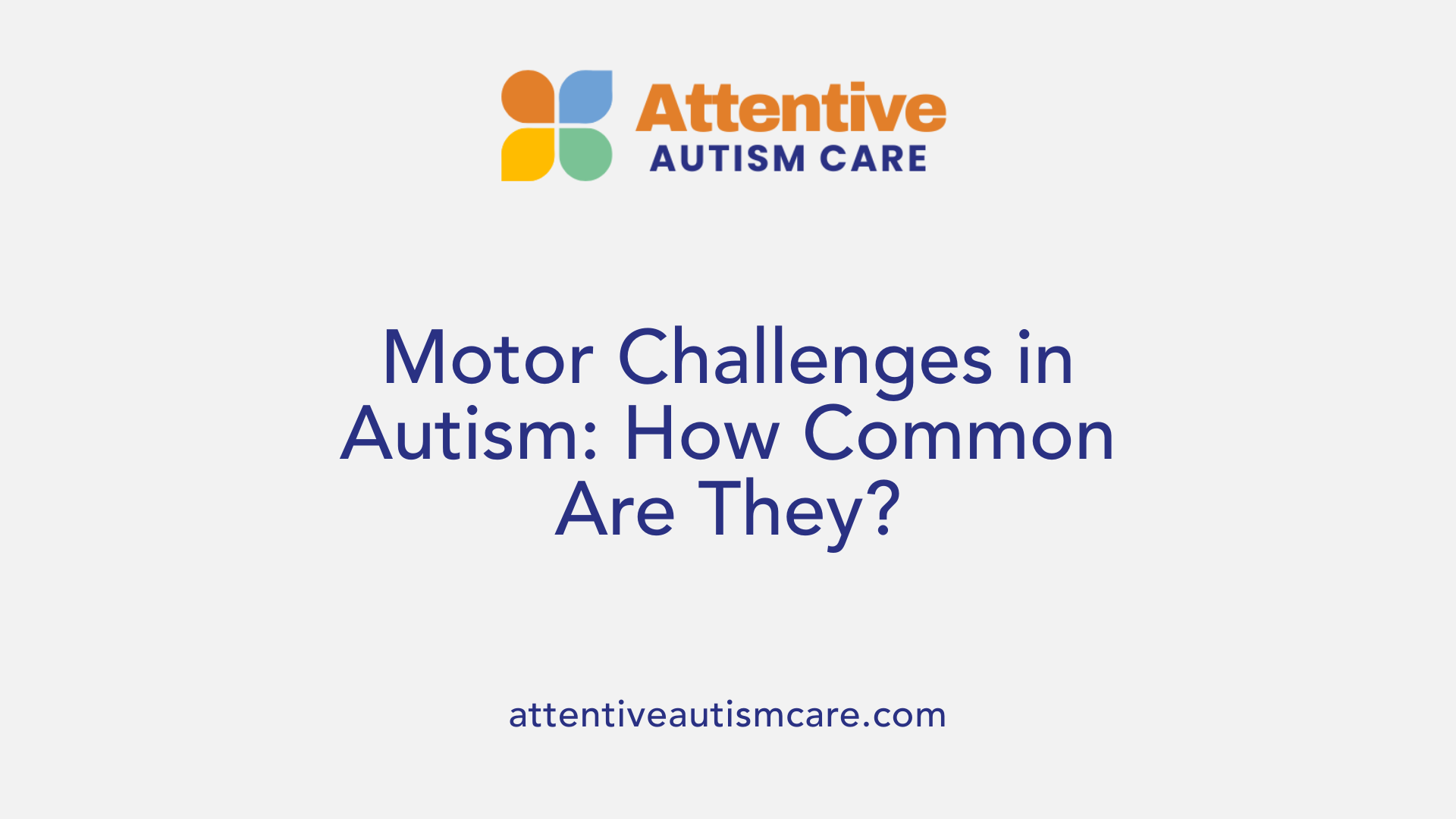
How common are motor problems in individuals with autism?
Research indicates that motor difficulties are highly prevalent among people with autism, with estimates ranging from 50% to 95%. Up to 87% of children with autism aged 5 to 15 years are at risk of experiencing movement challenges. These motor problems include issues with posture, coordination, balance, and gait, affecting both fine and gross motor skills. Studies show that motor deficits are present from early infancy, with delays in milestones such as sitting, crawling, and standing. Over time, these difficulties often persist into adulthood, impacting physical health, mobility, and participation in daily life activities.
What types of motor impairments are observed?
Autistic individuals often exhibit a broad range of motor impairments, including:
- Motor stereotypies such as hand flapping and repetitive movements
- Delays in motor milestone achievement (e.g., sitting, walking, grasping objects)
- Fine motor control issues like handwriting difficulties and manipulating small items
- Gross motor challenges including balance, coordination, and gait problems
- Poor motor planning or praxis, affecting the ability to perform complex sequences of movements
- Low muscle tone (hypotonia) and joint hypermobility
- Atypical gait patterns and decreased manual dexterity These challenges are linked to differences in brain connectivity, especially involving the cerebellum and motor regions.
How do motor problems affect daily activities?
Motor impairments significantly influence everyday functioning. Difficulties with posture and coordination can hinder activities like dressing, using cutlery, or participating in sports. Balance issues increase the risk of falls and injuries, posing safety concerns especially during physical play. Challenges in fine motor control impact academic tasks such as handwriting and grasping objects, limiting independence and learning opportunities.
Moreover, motor delays can reduce social participation, as activities like playing on playground structures, riding bikes, or engaging in group sports become more difficult. This limits opportunities for social interaction and learning, further affecting emotional development. Early motor problems are also associated with delays in language development, social communication, and cognitive skills, emphasizing the importance of early assessment and intervention.
The high prevalence of motor issues and their impact on daily life highlight the need for comprehensive motor evaluation and support tailored to individual needs. Incorporating strategies such as physical therapy, occupational therapy, and targeted motor skill training can improve mobility, functional independence, and overall quality of life for autistic individuals.
| Aspect | Description | Example/Impact |
|---|---|---|
| Prevalence | 50% to 95% affected | High across age groups |
| Motor impairments | Coordination, balance, gait | Walking delays, falls |
| Types | Gross and fine motor issues | Handwriting struggles, running difficulties |
| Daily impact | Self-care, social participation | Dressing, playground activities |
| Underdiagnosis | Only about 1% documented | Need for better screening |
| Interventions | Therapy and activity programs | Physiotherapy, adapted sports |
Scientific Evidence on Motor Impairments in Autism
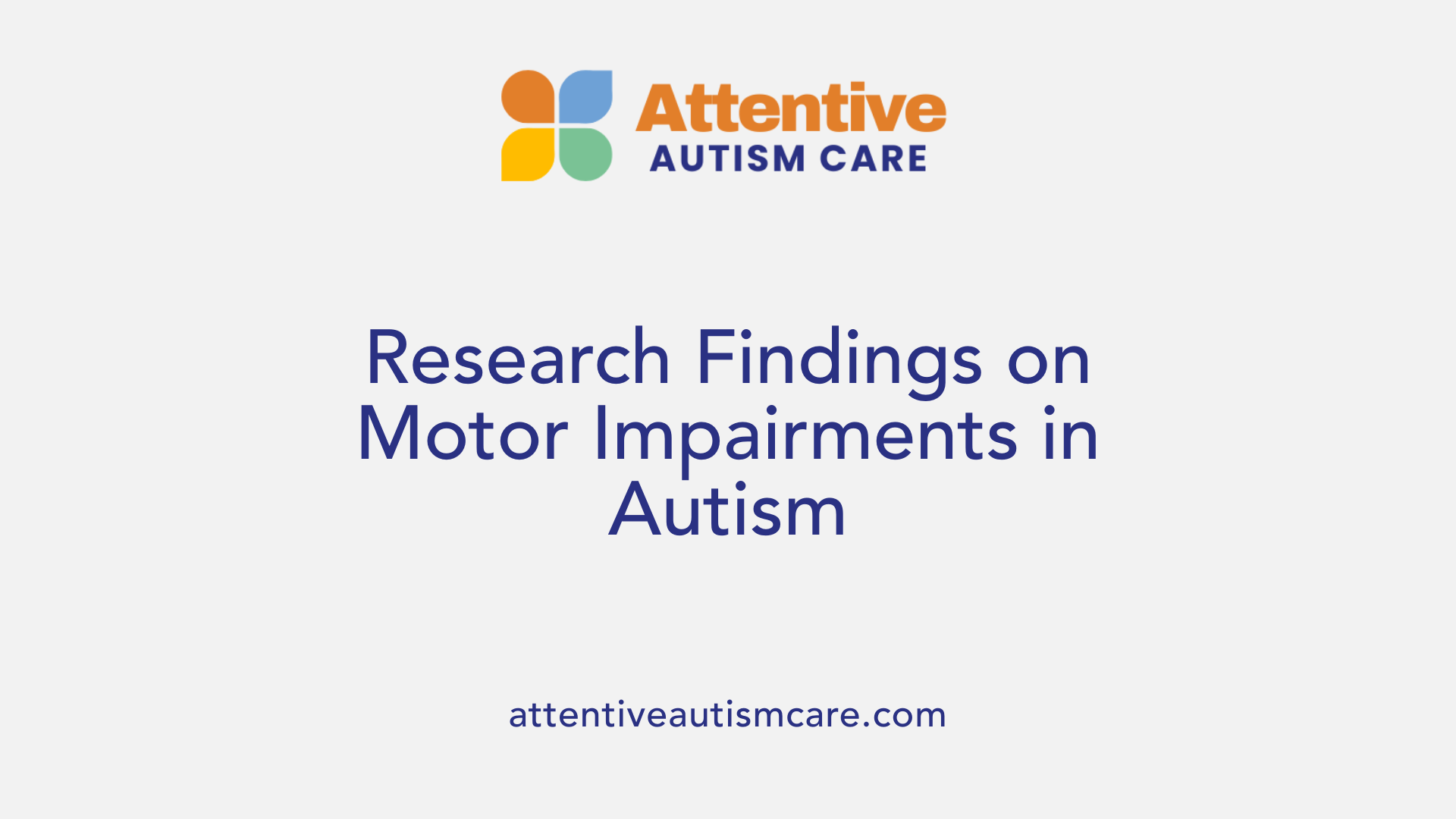
What are the scientific findings regarding motor impairments in individuals with autism?
Research consistently indicates that motor impairments are highly prevalent among autistic individuals, affecting over 50% to 95% of this population. These challenges encompass a wide spectrum, including difficulties with coordination, balance, gait, and both fine and gross motor skills. From early infancy, signs such as delays in motor milestones—like sitting, crawling, and standing—are observable markers that can signal autism.
Children with autism often show lower scores on motor development assessments, with impairments identified in activities such as ball handling, jumping, and using utensils. Notably, these motor difficulties do not only exist alongside cognitive or language delays but also independently impact social participation and daily functioning.
Meta-analyses reinforce these findings, revealing significant deficits in motor coordination, manual dexterity, and postural stability across studies. Such impairments continue into adulthood, affecting mobility, balance, and voluntary movements, which can lead to increased fall risks and reduced independence.
The presence of motor problems influences social engagement, academic achievement, and overall quality of life. For example, early motor delays can hinder opportunities for social interactions, which are crucial for language and emotional development. Regular assessments using tools like the Movement Assessment Battery for Children or caregiver questionnaires help identify these difficulties, enabling timely intervention.
Targeted physical and occupational therapies have demonstrated efficacy in improving motor skills, and emerging modalities such as movement-based sports and yoga show promising results in enhancing coordination, balance, and adaptive skills.
What neurobiological factors contribute to motor difficulties in autism?
The neurological underpinnings of motor impairments in autism are complex and multifaceted. Key neurobiological contributors include differences in brain connectivity. Studies have identified decreased synchronization between the visual and motor regions, which may impair movement planning and execution.
Furthermore, the cerebellum, a brain structure essential for coordinating movement, is often found to have structural and functional differences in autistic individuals. These variations can disrupt the regulation of movement accuracy, timing, and balance.
Reduced connectivity between the inferior parietal lobe—integral for sensory integration—and the cerebellum further hampers the processing required for smooth motor control. Sensory processing differences, such as greater reliance on proprioception rather than visual cues during movement learning, are also common and contribute to motor planning difficulties.
Overall, these neurobiological differences underlie many of the observable motor challenges in autism, including gait abnormalities, poor coordination, and balance issues. Understanding these mechanisms can guide the development of targeted interventions aimed at enhancing motor function and, consequently, social and cognitive outcomes.
| Aspect of Motor Impact | Observed Features | Underlying Neurobiological Factors |
|---|---|---|
| Coordination | Atypical gait, manual dexterity issues | Decreased connectivity between cerebellum and sensory regions |
| Balance | Postural instability, fall risk | Reduced activity synchronization in motor regions |
| Motor planning | Difficulties in imitation and gesture use | Differences in brain wiring and sensory integration |
Additional Information
Motor problems in autism not only derive from neural wiring but also involve sensory system dysfunctions, including issues with vestibular and proprioceptive processing. These sensory challenges further complicate the motor control difficulties and may necessitate specific therapeutic approaches to improve overall movement and stability.
Recognizing the neurobiological basis of motor impairments emphasizes the importance of early assessment and personalized interventions. Incorporating movement-based therapies that target sensory integration and neuroplasticity can promote better motor and social development, ultimately improving the quality of life for individuals with autism.
Assessment Methods for Motor Skills in Autism
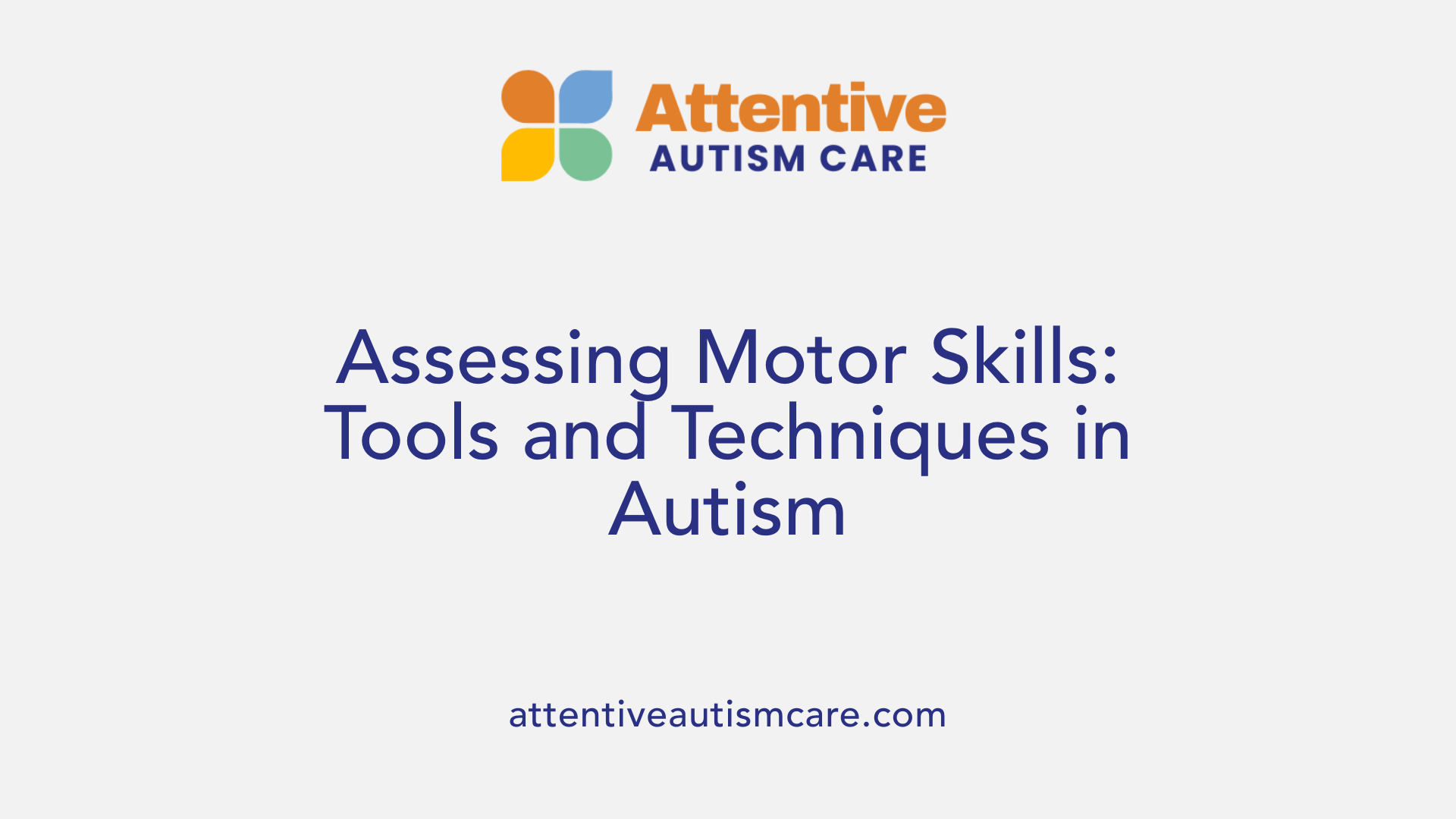
How are motor skills assessed in individuals with autism?
Assessing motor skills in individuals with autism involves a multifaceted approach to identify specific strengths and challenges in motor development. Clinicians utilize various standardized tests that have been specifically designed or adapted for children and adults with autism.
These tests include the Bruininks-Oseretsky Test of Motor Proficiency (BOT-2), which evaluates motor coordination, balance, manual dexterity, and strength. The Movement Assessment Battery for Children (MABC-2) is another widely used tool that assesses manual dexterity, ball skills, and balance, helping to pinpoint areas needing intervention. The Test of Gross Motor Development (TGMD-2) focuses on fundamental motor skills such as running, jumping, and crawling. Additionally, the Peabody Developmental Motor Scales (PDMS-2) provide insights into gross and fine motor abilities across a broad age range.
Besides these standardized tools, observational assessments and caregiver reports play a vital role. Instruments like the Assessment of Motor and Process Skills (AMPS) observe how children perform daily tasks involving motor coordination, while the Pediatric Evaluation of Disability Inventory (PEDI–C) assesses self-care capabilities that depend on motor function.
While these assessments offer valuable information, it is important to note that many standard tests are validated on neurotypical populations. This can sometimes limit their sensitivity or accuracy when used with autistic individuals. As a result, there is a growing emphasis on developing or adapting assessment measures that better capture autism-specific motor profiles.
Overall, an effective motor assessment combines standardized testing, detailed observation, and caregiver input. This comprehensive approach helps in identifying precise motor deficits, which can then be targeted through tailored therapeutic interventions, ultimately improving functional abilities and participation in daily life activities.
Interventions and Strategies for Enhancing Motor Skills
What are the motor features of autism?
Motor features in autism are diverse and include behaviors like motor stereotypies—such as hand flapping, rocking, or spinning—and differences in motor control and coordination. Many autistic individuals experience challenges in maintaining posture, executing coordinated movements, and achieving motor milestones. These issues can manifest as postural instability, difficulties with hand–eye coordination, and problems with both fine and gross motor skills.
How early do motor differences appear in children later diagnosed with autism?
Research shows that motor differences are often among the earliest signs of autism. Infants who are later diagnosed tend to exhibit delays in milestones such as sitting, crawling, and walking, with little use of motor skills during social interactions. These delays typically emerge between 6 and 36 months and include problems with grasping objects, sitting up, and other foundational motor skills.
Do motor problems persist into adulthood?
Yes, motor difficulties in autism can persist across the lifespan. Adults with autism often face issues with static and dynamic balance, gait abnormalities, and difficulties with functional mobility. These persistent problems can affect daily activities, participation in social and recreational pursuits, and increase the risk of falls and injuries.
How prevalent are motor problems among autistic individuals?
Motor challenges are highly prevalent, affecting from half to nearly all autistic people—estimates range from 50% to 95%. Despite this high occurrence, motor problems are frequently underdiagnosed in clinical settings, with only about 1% of autistic individuals documented with motor issues in practice. This discrepancy highlights a significant gap between research findings and clinical recognition.
Are early motor delays markers for autism?
Indeed, delays in sitting, crawling, and limited use of motor skills during social interactions are considered early markers. These early motor signs can be warning indicators for developmental assessments and are useful for early diagnosis, which is crucial for timely intervention.
What is the relationship between motor problems and social communication?
Motor difficulties are strongly associated with social and communication performance. For example, challenges with imitation, gesture use, and praxis—the ability to perform coordinated movements—are linked to deficits in social interaction and language development. Many researchers also note a significant overlap between motor impairments in autism and developmental coordination disorder (DCD), though there's ongoing debate about whether these are distinct or share common underpinnings.
How are motor problems assessed?
Assessment tools include caregiver questionnaires like the Developmental Coordination Disorder Questionnaire, which gathers information from parents about daily motor behaviors. Observational measures such as the Movement Assessment Battery for Children (MABC) and the Bruininks-Oseretsky Test of Motor Proficiency (BOT-2) are used to objectively evaluate motor skills. Emerging techniques like handwriting analysis, virtual reality environments, motion capture, and sensors are also being explored, though they are not yet standardized.
Why would adding a motor impairment specifier to ASD diagnosis help?
Including a motor impairment specifier could improve the recognition, documentation, and overall understanding of motor difficulties within ASD. This addition would facilitate earlier diagnosis and targeted intervention, providing better access to physical and occupational therapies and enhancing overall quality of life. It would also bridge the gap between research insights and clinical practice.
How do motor issues relate to other features like IQ and developmental conditions?
Motor problems are present across the spectrum, with or without intellectual disability. They have been observed independently of cognitive and sensory functions, and can even predict later developmental outcomes. For instance, reduced coordination and balance are associated with the severity of autism traits. Additionally, certain genetic mutations linked to autism, such as those seen in syndromic forms like Phelan-McDermid syndrome and dup15q syndrome, show specific motor deficits like low muscle tone and characteristic gait patterns.
What brain differences underlie motor difficulties in autism?
Research suggests that differences in brain connectivity and structure contribute to motor challenges. Altered activity in the cerebellum, which regulates movement precision and timing, has been observed in autistic individuals. Connectivity between the visual and motor regions, as well as within the cerebellum and other motor-related areas like the inferior parietal lobe, may be decreased. These neural differences disrupt coordination, posture, balance, and motor planning.
How do motor difficulties affect social and cognitive development?
Motor problems in early life can delay babbling, gesturing, and vocabulary acquisition, impacting social, emotional, and cognitive growth. Limited motor ability reduces opportunities for social engagement, especially in activities like sports, playing, or participating in social groups. This, in turn, can hinder learning social cues and building relationships, potentially exacerbating social communication challenges.
What strategies are effective in managing motor challenges in autism?
Interventions such as physical and occupational therapy target core motor skills, focusing on improving strength, coordination, balance, and motor planning. Early, tailored programs that include core stability exercises, praxis, and coordination training can significantly improve motor abilities.
Emerging and innovative approaches involve robotics, active video games, and sensory-based activities designed to motivate children and promote motor learning. Activities like trampolining, swimming, yoga, martial arts, and movement-based therapies incorporating music can develop balance, proprioception, and coordination.
Repetition and consistent practice are fundamental, enabling skill retention and transfer to daily life. Early intervention is particularly effective, as it leverages neuroplasticity to reduce delays and promote better developmental trajectories.
How do motor improvements impact social participation?
Enhanced motor skills can lead to increased confidence and independence, facilitating greater engagement in recreational, academic, and social activities. Structured programs that combine motor skill training with social and cognitive strategies have been shown to improve social participation, reduce frustration, and foster a sense of achievement.
Participation in adapted sports, dance, martial arts, and music-based movement therapies not only builds physical abilities but also promotes social interactions and belonging, ultimately improving quality of life.
Developmental and Lifespan Perspective on Motor Skills in Autism
How does motor coordination in autism differ across age groups?
Motor coordination in individuals with autism spectrum disorder (ASD) varies across different ages but generally shows significant delays and differences in both gross and fine motor skills. In early childhood, particularly between 6 and 36 months, infants who later receive an autism diagnosis often exhibit developmental delays, such as weak head control, difficulty sitting, crawling, and limited use of motor skills during social interactions.
As children grow, these motor difficulties tend to persist and sometimes become more evident. For children aged 3 to 5 years, issues like balance problems, coordination challenges, and delayed motor milestones are common. During school age, deficits can affect participation in sports, riding a bike, or handwriting, which impacts social participation and academic performance.
In adolescence and adulthood, motor challenges are still present and often include problems with static and dynamic balance, gait abnormalities, and manual dexterity difficulties. These can interfere with daily activities such as walking steadily, maintaining posture, or performing tasks requiring fine motor control.
Research shows that motor impairments in autism become more apparent with age, correlating with broader developmental delays. The severity of these challenges may also increase or fluctuate over time, emphasizing the importance of ongoing assessment.
Overall, motor coordination differences in autism are not isolated to childhood; they are persistent features across the lifespan. Early detection and interventions targeted at improving motor skills can positively influence social integration, cognitive development, and overall quality of life.
What is the significance of early motor development assessments?
Assessing motor development early in children suspected of having autism holds significant importance for several reasons. Motor delays, such as reduced arm movement, weak head control, and difficulty standing or grasping objects, often appear before or alongside other early signs of autism.
Identifying these early motor difficulties allows clinicians and parents to trigger further evaluations for autism, leading to earlier diagnoses. Early detection of motor impairments serves as a crucial marker because it offers a window of opportunity where intervention can be highly effective.
Early assessment can help differentiate autism from other developmental conditions and provide insight into the developmental trajectory. Moreover, addressing motor issues promptly through therapies like physical or occupational therapy can support overall development.
Interventions during this critical period can improve motor coordination, balance, strength, and manual dexterity, which are essential for daily life activities and social engagement. Better motor skills facilitate participation in play, social interactions, and adaptive activities, reducing the risk of secondary developmental or emotional problems.
In summary, early motor development assessments are vital for timely intervention, which can improve long-term outcomes in children with autism by enhancing their physical, cognitive, and social capacities for life.
Practical Activities and Resources for Improving Motor Skills
What are some recommended activities to improve motor skills in children with autism?
Enhancing motor skills in children with autism involves engaging them in a variety of activities that target both gross and fine motor development. Fine motor exercises could include sorting games, drawing, threading beads, weaving, and puzzles, which strengthen hand muscles and improve hand-eye coordination. Playing with dough, manipulating small objects, or creating paper clip chains also supports dexterity.
For gross motor development, activities such as jumping, balance exercises, or playing on equipment like trampolines and climbing frames help improve overall coordination, balance, and muscle strength. Building core stability is crucial, and exercises like sitting on stability balls, practicing yoga, or assuming high kneeling positions can be very beneficial.
Occupational therapy often employs tailored strategies and tools. These include squeezing stress balls, molding clay, or using stimulating toys like pegboards and stickers. Repetitive and sensory-rich activities are especially effective because they promote motor learning and can foster independence in daily routines.
Consistent play-based activities, which integrate sensory input and movement, support children's overall developmental progress. They also enhance social and emotional skills as children interact and communicate through these structured tasks.
How can daily routines be adapted to support motor skill development?
Daily routines offer excellent opportunities to incorporate motor skill practice seamlessly into children's everyday lives. For example, encouraging a child to dress themselves using elastic waistband clothing or practicing one-handed brushing during tooth care promotes the use of muscles involved in fine motor control.
Similarly, practicing the use of utensils with various grips or participating in simple tasks like buttoning, zipping, or lacing shoes can build manual dexterity. Stacking blocks, puzzles, or organizing toys can reinforce spatial awareness and coordination.
Establishing a consistent daily schedule that dedicates specific times for motor activities ensures regular practice. Integrating movement breaks during learning or play time—using sensory tools like textured mats, wobble cushions, or balance beams—can reinforce motor skills and reduce fatigue.
Making routines engaging and supportive through the use of visual aids, timers, or reward systems can motivate children. These adaptations not only develop motor skills but also foster independence and confidence, allowing children to participate more fully in home, school, and community activities.
Bridging Research and Practice for Better Outcomes
Understanding the significant impact of autism on motor coordination emphasizes the need for early assessment and tailored interventions. Continued research into neurobiological mechanisms and innovative therapeutic strategies offers hope for improving motor skills and, consequently, social participation, independence, and quality of life for individuals with autism. Fostering collaboration between clinicians, educators, and families is essential to implement effective support systems, ensuring that motor development challenges are addressed comprehensively across the lifespan.
References
- Motor problems in autism: Co-occurrence or feature? - PMC
- Autistic Children and Motor Skills
- Motor difficulties in autism, explained | The Transmitter
- A scoping review of the motor impairments in autism spectrum disorder
- Autism & motor control
- The impact of sensory integration based sports training on motor ...
- Motor signature of autism spectrum disorder in adults without ...
- Autism and Balance Issues: What's the Link? | BIFA
- Gross Motor Profile and Its Association with Socialization Skills in ...








